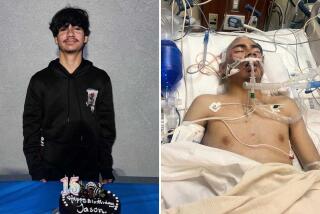Trial Begins in Fatal Beating of Black Man
- Share via
Using a larger-than-life image of the victim’s corpse as a grisly visual aid, prosecutors told jurors in opening statements Tuesday that four Antelope Valley youths bragged to friends about beating a homeless man to death because he was black and then later admitted the attack to investigators.
“In the 1950s and 1960s I think we all hoped that the violent expression of racism would be extinct right now,” Deputy Dist. Atty. Jacquelyn Lacey told jurors. “But you are about to learn that that is not the case.”
Three separate juries are hearing the hate crime murder case against three of the youths, who are accused in the fatal November 1995 attack on Milton Walker Jr. Prosecutors allege that the defendants espoused racist beliefs and attacked Walker because he was an African American.
“These four skinheads, Ritch Bryant, Randy Rojas, Michael Thornton and Jessica Colwell, sacrificed the life of Milton Walker in order to earn the right to wear lightning bolt tattoos,” Lacey told jurors. “In the skinhead group with which they were associated, this evil symbol is earned by killing a minority.”
If the juries agree that Rojas, Bryant and Colwell killed Walker out of racial hatred, they face life in prison without the possibility of parole. Thornton previously confessed to beating Walker and implicated the others. He is being tried separately on lesser charges of assault.
Defense lawyers do not contest the attack, but each says that his own client did not deliver the fatal blows. Walker was allegedly beaten twice the night he died, with only one defendant present both times.
Lacey says Thornton, Rojas and Bryant were approached about 8 p.m. on Nov. 25, 1995, by a white woman who told them a black man had kicked her.
“According to their skinhead philosophy, a black man should be punished for hitting a white woman,” Lacey told jurors. “And Bryant, Rojas and Thornton decided to seek revenge.”
As they neared the vacant lot where Walker had set up camp, they saw him shove a white man, one of his homeless friends, and were allegedly further resolved to beat him. Thornton kicked and punched him, Lacey said, then Rojas took over, kicking Walker and bludgeoning him with a two-by-four. They allegedly yelled racial epithets during the attack.
The three suspects then left. But Bryant, who Lacey said was insistent upon getting his lightning bolt tattoo, later returned with Colwell. Bryant allegedly beat Walker with a stick while Colwell smashed his head with a pipe.
Some jurors were stunned by the description of the attack, as well as by the photos of Walker’s corpse that were projected on a wall.
Lacey also displayed the piece of wood and the L-shaped pipe found next to Walker’s body, covered in his blood. She showed the jurors pictures of Rojas’ and Bryant’s lightning bolt and other racist tattoos.
Rojas, 24, dressed in a navy blue jacket, light blue shirt and khaki pants, his hair slicked back, sat motionless. Colwell, 20, looked bored, fussing with her bright blue velvet top, her glasses and her hair.
Bryant, a lanky 20-year-old, also looked bored. He clasped his hands between his legs and squinted at documents as his defense lawyer described him as a racist and a braggart, but not a killer.
“He possibly witnessed the events,” said his lawyer, Norman Kallen, “but he did not do the crime.”
More to Read
Sign up for Essential California
The most important California stories and recommendations in your inbox every morning.
You may occasionally receive promotional content from the Los Angeles Times.













